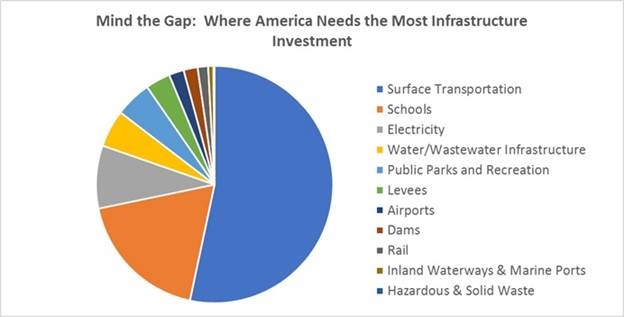With tax reform under its belt, the administration is turning its attention to a topic that the President used to good effect during the 2016 campaign -- infrastructure. It is also a topic that we have addressed frequently in these pages, noting the connection between adequate infrastructure and such critical barometers of economic health as productivity growth. U.S. public infrastructures -- roads, bridges, ports, airports, public buildings, levees, railroads, waterways, and so forth -- stand in need of a good deal of investment to continue to support robust economic growth (see our commentary of April 27, 2017).

When many investors think of these infrastructure investments, they probably imagine steel and concrete as the critical physical ingredients for infrastructure. But there is another, pervasive ingredient that they may overlook: chemicals.
Concrete requires chemical additives. Most construction requires coatings. Much requires piping, often made from PVC (polyvinyl chloride), or more advanced resins and other materials. Adhesives are critical parts of most of the infrastructure categories mentioned above. Besides being general beneficiaries of a big infrastructure push, chemical companies are also benefitting from a secular tailwind: pricing power from the roll-out of innovative, “greener” chemicals that eliminate harmful ingredients (such as bisphenol-A), enhance energy efficiency, and so on.
When considering the impact of infrastructure spending, don’t neglect chemicals.
Investment implications: Unless partisanship escalates in the run-up to mid-term elections, there is a good chance that common interests across the political divide could help advance an infrastructure bill. As it gets closer, consider chemical companies: DowDuPont I(NYSE:DWDP), about to divide itself into agricultural, materials, and specialty chemical products; PPG Industries (NYSE:PPG), which makes coatings; and RPM International (NYSE:RPM), whose offerings focus on repair and maintenance.
Please note that principals of Guild Investment Management, Inc. (“Guild”) and/or Guild’s clients may at any time own any of the stocks mentioned in this article, and may sell them at any time. Currently, Guild’s principals and clients own DWDP. In addition, for investment advisory clients of Guild, please check with Guild prior to taking positions in any of the companies mentioned in this article, since Guild may not believe that particular stock is right for the client, either because Guild has already taken a position in that stock for the client or for other reasons.
Market Summary
U.S. Outlook: A New Profit Cycle for the U.S.
Fourth-quarter U.S. profits continue to come in, and they are very strong.
Some analysts are arguing, and we agree, that U.S. corporate profits are in a new upcycle.
U.S. corporate profits declined in 2015 by about 11%. In 2016 profits rose moderately, so in the two-year span from 2015 to 2016 there was very modest profit growth.
In 2017, corporate earnings started to rise a little more rapidly than in the previous two years. The most interesting point is that earnings began to accelerate during the year, and increased their acceleration in the fourth quarter. So far, with 92% of the S&P 500 having reported fourth quarter, S&P 500 operating earnings are up 22.3% from one year earlier.
This is a very large earnings increase, and analysts at the New York and Atlanta Federal Reserve currently predict a real GDP growth rate of about 3.1%. This equates to about 5.8% nominal GDP growth in 2018.
In short, 2018 U.S. GDP growth will be strong.
The historical records indicates that 5.8% nominal GDP growth strongly supports the probability of much higher earnings in 2018. Even though labor and interest costs will rise somewhat, we anticipate that operating profit margins will stay strong and that after-tax corporate profits will rise 9–15% in 2018.
All other things being equal, those companies in the fast-growing sectors of the economy (specifically, financials, techs, and industrials) should do better than the market as a whole.
We remain bullish on these sectors, and suggest adding to positions in these sectors on the inevitable market corrections which will continue to occur as interest rates gradually rise.
Those who listened to our recent conference call, or who regularly read these pages, know that our danger points for a market reversal do not appear to be imminent. The danger points include (1) a very rapid increase in the value of the dollar; (2) two-year interest rates on U.S. Treasury securities higher than 10-year rates; (3) a major war; and (4) a world banking crisis.
None of these are near-term problems; for this reason we remain very optimistic about corporate profit growth in 2018.
Emerging Markets
Emerging markets are attractive -- especially those which grow by manufacturing as opposed to commodity price appreciation. Our favorites are China, India, Vietnam, and Chile.
In all four countries, growth is strong, and although China has an overleveraged banking system, they are taking action to correct the problem by forcing irresponsible companies to pare back their speculation. One such company, Anbang Insurance, has been taken over by the Chinese government, which will reduce the company’s excessive risk taking.
Europe And Japan
In our view, Europe has many hurdles to cross in 2018, including contentious elections in several countries, Brexit negotiations, the rise of populist parties in many countries, and slower growth as a result of a high euro. We are not bullish on Europe.
Japan depends upon the moves in the U.S. dollar. At the current level of the U.S. dollar, or if the dollar strengthens, Japan will make progress. On the other hand, if the Japanese yen rises too much, the stock market will retreat, because exports will moderate. The central bank continues to buy bonds and stocks to support economic growth, and they are meeting with some success as growth is improving. Inflation has not yet rebounded to a high enough level, so Japan’s central bank continues to fight deflationary forces.
Gold
Gold continues in a trading range. As inflation begins to rise toward 3–4% in 2018, we will see modest appreciation in gold, but we do not look for a major rise. A price above $1500/ounce in 2018 will surprise us.
Digital Currencies
After a tumultuous few months, bitcoin and many other digital currencies have returned to a more typical level of volatility -- which is still highly elevated compared to most other asset classes. At this writing, bitcoin remains nearly 50% below the December highs.
Incrementally, the regulatory news for digital currencies has been positive. In our article above we note how the Swiss canton of Zug has embraced digital currencies. Many eagerly reported regulatory actions have turned out not to be as onerous as first reports suggested. Congressional hearings in the United States produced commentary from regulators that indicated support for digital currency innovations. Digital currencies are still a speculative “Wild West”; the Venezuelan government’s launch of an allegedly oil-backed digital currency demonstrates that there will continue to be unscrupulous actors eager to take advantage of froth and exuberance among digital currency speculators.
We continue to look for a regulatory “sweet spot” that reins in criminality and manipulation while still permitting innovation to flourish. We suspect other crypto watchers would like to see the same developments, and if they occur, it will be bullish for many crypto assets. Similar bullish developments will include the successful deployment of new technologies that help crypto transactions be faster and cheaper; we commented on some of these emerging technologies in our recent conference call.
